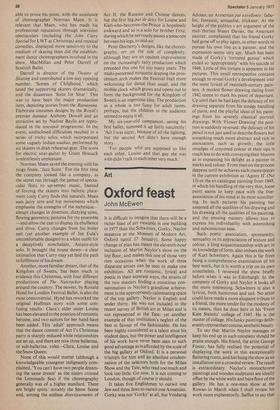Art
Oxford feast
John McEwen
It is difficult to imagine that there will be a richer feast of art viewable in one building in 1977 than the Schwitters, Gorky, Naylor sequence at the Museum of Modern Art, Oxford (until 17 January). Some happy change of plan has meant the eleventh-hour inclusion of Martin Naylor's show on the top floor, and makes this one of those very rare occasions when the work of three disparate artists can be seen to make one exhibition. All are romantic, lyrical and poetic in their separate ways, the strains of the two masters finding a conscious consummation in Naylor's grandiose achievement in the appropriately culminating space of the top gallery. Naylor is English and under thirty. He was not included in the recent survey of British art in Milan and is not represented at the Tate: yet another example of that institution's neglect of the best in favour of the fashionable. He has been highly considered as a talent since his student days, but the power and intelligence of his work have never been seen to such good advantage as is afforded by the scale of the big gallery at Oxford. It is a personal triumph for him and an absolute condemnation of the selectors both for the Milan Show and the Tate, who read too much and look too little. Go now. It is not coming to London, though of course it should.
It takes five Englishmen to outwit one Jew and three Jews to outwit one Armenian. Gorky was not 'Gorky' at all, but Vosdanig
Adoian, an Armenian par excellence: fabulist, fantasist, sensualist, trickster. At the height of the politics v art argument of the mid-'thirties Stuart Davies, the American painter, complained that his friend Gorky had gone off to play again, in other words to pursue his own line as a painter, and the expression seems very apt. Much has been made of Gorky's 'tortured genius' which ended so 'appropriately' with his suicide in 1948. Little of this torture is apparent in his pictures. This small retrospective contains enough to reveal Gorky's development into the most lyrical of twentieth-century painters. A modest flower drawing dating from 1942 seems to mark his point of departure. Up until then he had kept the delicacy of his drawing separate from his stodgy handling of paint, and the playful ideas of his paintings from his severely classical portrait drawings. With 'Flower Drawing' the position is suddenly reversed : the delicacy of his pencil is not just used to describe flowers but something much more abstract and rich in association, such as growth; the little smudges of crayoned colour at their tips is much less to do with conveying their blooms as in expr.essing his delight as a painter in marks and colour. From then on the process deepens until he achieves such masterpieces in the current exhibition as 'Agony II' (No 13) or the ex-catalogue painting from 1948, in which his handling of.the very thin, loose paint seems to keep pace with the freeassociation of his mind at its most scintillating. In such pictures his painting has assumed all the qualities of his drawing and his drawing all the qualities of his painting, and the ensuing mastery allows him to express his individuality with astonishing and subconscious ease.
Such poetic association, spontaneity, sensuality in its appreciation of texture and colour, a long acquaintanceship with art in its knowledge of form, also imbues the work of Kurt Schwitters. Again this is far from being a comprehensive examination of his best work, but it is worth a trip on its own nonetheless. I reviewed the show briefly before when it was in Edinburgh. In the company of Gorky and Naylor it looks all the more interesting. Schwitters is also a lyricist, both humorous and sad. No artist could have made a more eloquent tribute to a friend, the more tender for the modesty of its means, than he does here in his 'From Kate Steinitz' collage of 1945. He is the master of collage. His funky paintings deliberately oppose their concise, aesthetic beauty.
To say that Martin Naylor manages to keep his end up in such company should he praise enough. His friend, the artist George Foster, has fully realised the potential of displaying the work in this exceptionally flattering room, and has hung the show as an installation not a crowded review. The result is extraordinary. Naylor's monochrome paintings and wooden sculptures are ideally offset by the white walls and bare floor of the gallery. He has a one-man show at the Rowan in March when I shall review his work more explanatorily. Suffice to say that he too is a lyricist, more gothic and theatrical than such predecessors as Gorky and Schwitters but no less romantic. In smaller sPaces his work can look decorative because Of the proximity, the impossibility of seeing it whole. At Oxford its strength and the purPose of its sequences are revealed. What a relief it is to have a good douche Of romantic painting once again, away from the verbiage of utilitarianism, the selfJustification of those deadly 'systems,' both of which continue to be all the rage in England and elsewhere. These three shows demonstrate that the best art still seems to be that which most acknowledges mystery. One of Naylor's pieces is entitled 'Mutatis Mutandis2 Schwitters, Gorky, Naylor: niutatis mutandis indeed.



































 Previous page
Previous page